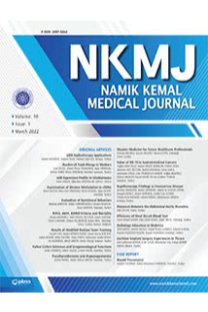OPERE ERKEN EVRE AKCİĞER KANSERİ HASTALARINDA PROGNOSTİK FAKTÖRLER RETROSPEKTİF TEK MERKEZ SONUÇLARI
Prognostic Factors in Operated Early Stage Lung Cancer Patients- Retrospective Single Center Data
___
- 1. Siegel RL, Miller KD, Jemal A. Cancer statistics, 2020. CA Cancer J Clin 2020; 70:7.
- 2. Cheng TY, Cramb SM, Baade PD, Youlden DR, Nwogu C, Reid ME. The International Epidemiology of Lung Cancer: Latest Trends, Disparities, and Tumor Characteristics. J Thorac Oncol. 2016;11(10):1653-71.
- 3. Didkowska J, Wojciechowska U, Mańczuk M, Łobaszewski J. Lung cancer epidemiology: contemporary and future challenges worldwide. Ann Transl Med. 2016;4(8):150. doi:10.21037/atm.2016.03.11
- 4. Goldstraw P, Crowley J, Chansky K, et al. The IASLC Lung Cancer Staging Project: proposals for the revision of the TNM stage groupings in the forthcoming (seventh) edition of the TNM Classification of malignant tumours [published correction appears in J Thorac Oncol. 2007 Oct;2(10):985]. J Thorac Oncol. 2007;2(8):706–14.
- 5. Battafarano RJ, Piccirillo JF, Meyers BF, et al. Impact of comorbidity on survival after surgical resection in patients with stage I non-small cell lung cancer. J Thorac Cardiovasc Surg 2002; 123:280.
- 6. Yi E, Bae MK, Cho S, Chung JH, Jheon S, Kim K. Pathological prognostic factors of recurrence in early stage lung adenocarcinoma. ANZ J Surg.2018;88(4):327–31.
- 7. Varlotto JM, Recht A, Nikolov M, Flickinger JC, Decamp MM. Extent of lymphadenectomy and outcome for patients with stage I nonsmall cell lung cancer. Cancer. 2009;115(4):851–8.
- 8. Hsu CP, Hsia JY, Chang GC, et al. Surgical-pathologic factors affect long-term outcomes in stage IB (pT2 N0 M0) non-small cell lung cancer: a heterogeneous disease. J ThoracCardiovasc Surg. 2009;138(2):426–33.
- 9. Devesa SS, Bray F, Vizcaino AP, Parkin DM. International lung cancer trends by histologic type: male:female differences diminishing and adenocarcinoma rates rising. Int J Cancer. 2005;117(2):294–9.
- 10. Yousem SA, Beasley MB. Bronchioloalveolar carcinoma: a review of current concepts and evolving issues. Arch Pathol Lab Med. 2007;131(7):1027–32.
- 11. Travis WD, Brambilla E, Nicholson AG, et al. The 2015 World Health Organization Classification of Lung Tumors: Impact of Genetic, Clinical and Radiologic Advances Since the 2004 Classification. J Thorac Oncol 2015; 10:1243.
- 12. Yoshizawa A, Motoi N, Riely GJ, et al. Impact of proposed IASLC/ATS/ERS classification of lung adenocarcinoma: prognostic subgroups and implications for further revision of staging based on analysis of 514 stage I cases. Mod Pathol 2011;24:653-64.
- 13. Hung JJ, Jeng WJ, Chou TY, et al. Prognostic value of the new International Association for the Study of Lung Cancer/American Thoracic Society/European Respiratory Society lung adenocarcinoma classification on death and recurrence in completely resected stage I lung adenocarcinoma. Ann Surg 2013; 258:1079-86.
- 14. Nitadori J, Bograd AJ, Kadota K, et al. Impact of micropapillary histologic subtype in selecting limited resection vs lobectomy for lung adenocarcinoma of 2cm or smaller. J Natl Cancer Inst 2013;105:1212-11.
- 15. Song Z, Zhu H, Guo Z, et al. Prognostic value of the IASLC/ATS/ERS classification in stage I lung adenocarcinoma patients--based on a hospital study in China. Eur J Surg Oncol 2013;39:1262-8.
- 16. Tsuta K, Kawago M, Inoue E, et al. The utility of the proposed IASLC/ATS/ERS lung adenocarcinoma subtypes for disease prognosis and correlation of driver gene alterations. Lung Cancer 2013;81:371-6.
- 17. Sayar A, Turna A, Solak O, Kiliçgün A, Urer N, Gürses A. Nonanatomic prognostic factors in resected nonsmall cell lung carcinoma: the importance of perineural invasion as a new prognostic marker. Ann Thorac Surg. 2004;77(2): 421–5.
- 18. Shoji F, Haro A, Yoshida T, et al. Prognostic significance of intratumoral blood vessel invasion in pathologic stage IA nonsmall cell lung cancer. Ann Thorac Surg. 2010;89(3):864–9.
- 19. Macchiarini P, Fontanini G, Harbin MJ, et al. Blood vessel invasion by tumor cells predicts recurrence in completely resected T1N0Mo non-small-cell lung cancer. J Thorac Cardiovasc Surg 1993;106:80–9.
- 20. Al-Alao BS, Gately K, Nicholson S, McGovern E, Young VK, O'Byrne KJ. Prognostic impact of vascular and lymphovascular invasion in early lung cancer. Asian Cardiovasc Thorac Ann. 2014;22(1):55–64.
- ISSN: 2587-0262
- Yayın Aralığı: 4
- Başlangıç: 2013
- Yayıncı: Galenos Yayınevi
PREMALİGN SERVİKOVAGİNAL SMEAR SONUÇLARININ KOLPOSKOPİ VE LEEP İLE KORELASYONU
İlke ÖZER ASLAN, Zeliha Zeynep SATILMIŞOĞLU, Erson AKSU
Gülhan Tunca ŞAHİN, Erkut ÖZTÜRK
COVİD-19 PANDEMİ DÖNEMİNDE ASTIM TANILI ERGENLERDE ANKSİYETE DÜZEYİNİN DEĞERLENDİRİLMESİ
Nurşen CİĞERCİ GÜNAYDIN, Saliha BAYKAL
Demet TERZİ, Ramadan Bilgin AKALIN, BERNA ERDAL
Eda SÜNNETÇİ, Aslı KIBRIS, Ferit DURANKUŞ
YAYGIN BÜYÜK B HÜCRELİ LENFOMA (YBBHL) TANILI OLGULARIN RETROSPEKTİF DEĞERLENDİRMESİ
Atakan TEKİNALP, Sinan DEMİRCİOĞLU, Volkan KARAKUŞ, Burhan TURGUT, Özcan ÇENELİ
Fethi Emre USTABAŞIOĞLU, Cihan ÖZGÜR, Derya KARABULUT, Nermin TUNÇBİLEK, Cesur SAMANCI
Yasin DURAN, Fatin Rüştü POLAT, Birol TOPÇU
ANXIETY SYMPTOMS IN HEALTHCARE WORKERS AND THEIR CHILDREN DURING THE COVID-19 PANDEMIC IN TURKEY
